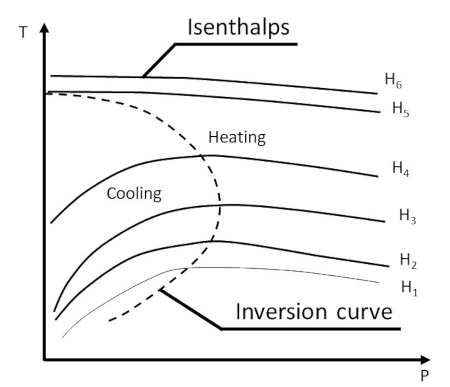20.19 : Joule-Thomson Effect
The Joule-Thomson effect, also known as the Joule-Kelvin effect, describes the temperature change of a fluid when it is forced through a valve or porous plug while keeping it in a thermally insulated environment. This experiment is called a throttling process. This is an important effect widely used in refrigeration and the liquefaction of gases.
This experiment forces high-pressure gas through a throttle valve or a porous plug to a lower-pressure region. The gas expands as it passes through to the low-pressure region and occupies the volume, which is larger than the initial volume. Work is done on the gas when gas is forced through a throttle valve. However, when it expands, work is done by the gas on the surroundings. The temperature of the gas varies in this process; hence, it attains a new internal energy. The change in internal energy of the gas must be equal to the work done on the gas minus the work done by the gas. It is found that enthalpy is conserved (isenthalpic) in this flow process.
The change in temperature of the gas when pressure is reduced at constant enthalpy is given by the Joule-Thomson coefficient:

Since the temperature of the gas varies, the Joule-Thomson coefficient can take either sign, depending on whether the gas becomes heated or cooled. The inversion curve in the T-p plane explains the heating and cooling of gas during the throttling process.

The inversion curve separates the region of heating from the region of cooling. The maxima of the different isenthalps lie on the inversion curve. Note that an isenthalp is the locus of the end points of different throttling processes, starting at the same initial state. Depending on where the initial and final points are chosen, both heating and cooling effects can be produced during the throttling process.
The Joule-Thomson coefficient is zero for an ideal gas, indicating there is no temperature change when an ideal gas undergoes a throttling process. The coefficient is negative for real gases at extremely high and extremely low temperatures.
来自章节 20:

Now Playing
20.19 : Joule-Thomson Effect
The First Law of Thermodynamics
2.6K Views

20.1 : 热力学系统
The First Law of Thermodynamics
4.9K Views

20.2 : 在体积更改期间完成的工作
The First Law of Thermodynamics
3.8K Views

20.3 : 热力学状态之间的路径
The First Law of Thermodynamics
3.0K Views

20.4 : 热和自由膨胀
The First Law of Thermodynamics
1.7K Views

20.5 : 内能
The First Law of Thermodynamics
4.4K Views

20.6 : 热力学第一定律
The First Law of Thermodynamics
4.0K Views

20.7 : 热力学第一定律:解决问题
The First Law of Thermodynamics
2.4K Views

20.8 : 循环进程和孤立系统
The First Law of Thermodynamics
2.7K Views

20.9 : 等温过程
The First Law of Thermodynamics
3.5K Views

20.10 : 等压和等压过程
The First Law of Thermodynamics
3.3K Views

20.11 : 理想气体的热容 I
The First Law of Thermodynamics
2.5K Views

20.12 : 理想气体的热容 II
The First Law of Thermodynamics
2.3K Views

20.13 : 理想气体的热容 III
The First Law of Thermodynamics
2.1K Views

20.14 : 理想气体的绝热过程
The First Law of Thermodynamics
3.0K Views
See More
版权所属 © 2025 MyJoVE 公司版权所有,本公司不涉及任何医疗业务和医疗服务。